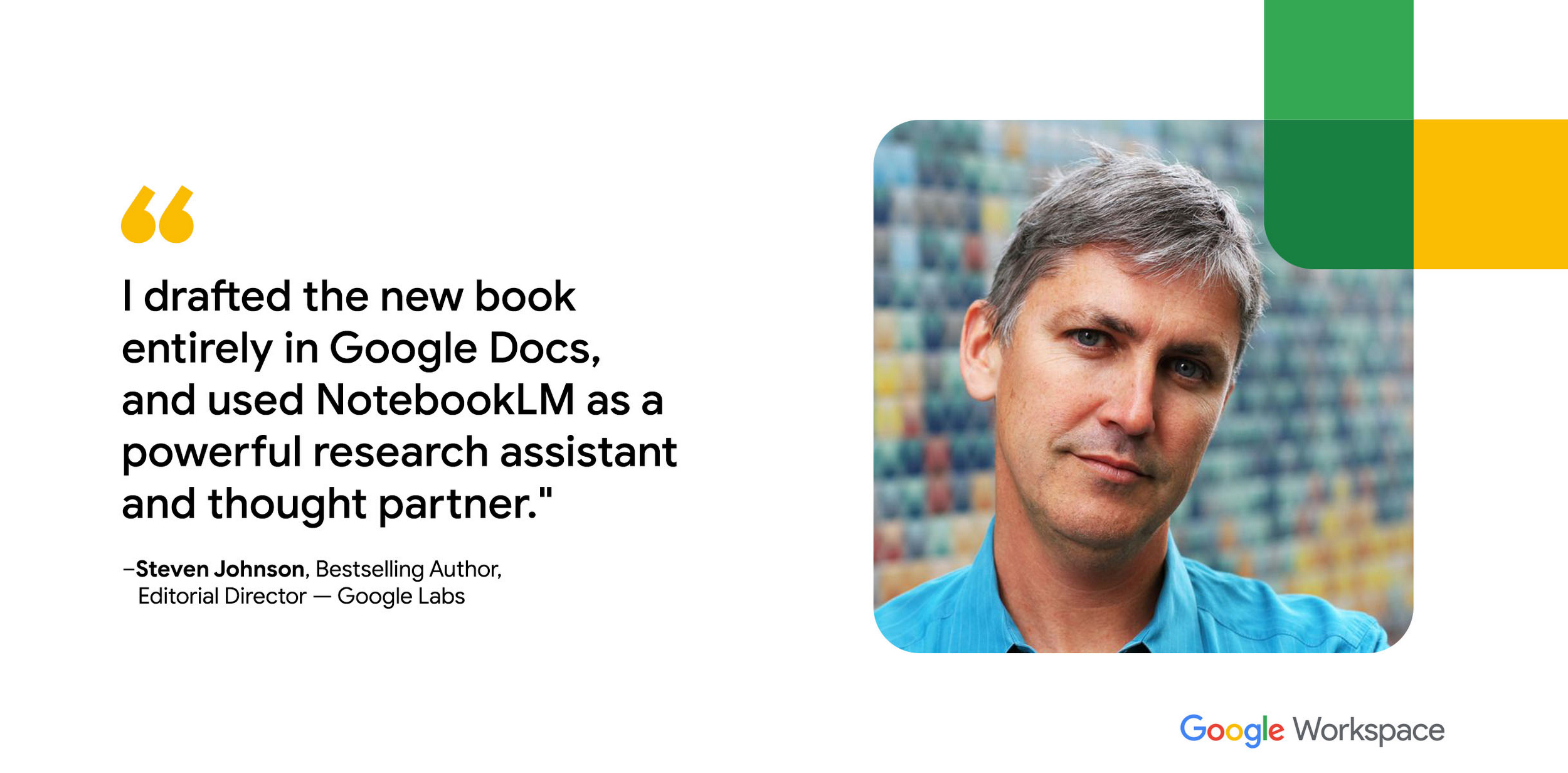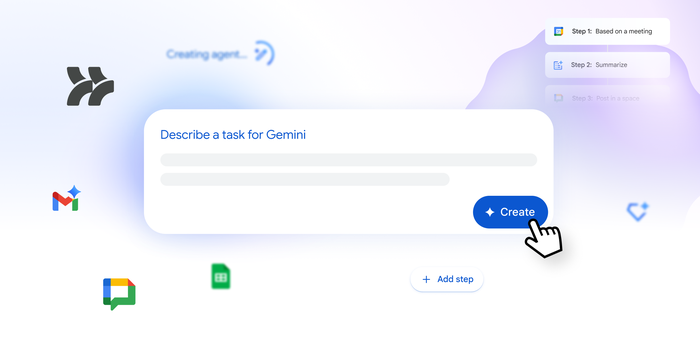Interview: How bestselling author Steven Johnson wrote his latest book with Google Docs and an AI-powered notebook

The Google Workspace Team
Google Workspace Newsletter
Keep up with the evolving future of work and collaboration with insights, trends, and product news.
SIGN UPSteven Johnson is the bestselling author of fourteen books on science, technology, and innovation, including Where Good Ideas Come From and the just-published The Infernal Machine. He also hosted and co-created the Emmy-winning PBS/BBC television series How We Got To Now and Extra Life. Steven is now the Editorial Director at Google Labs, where he helped develop the new AI-powered writing and research tool, NotebookLM. We sat down with Steven to ask him about his book, his writing process, and how he used Google Docs and AI to bring his latest project to life.
Workspace Team: More than a decade ago, you wrote a piece on Medium called The Spark File, about a single Google Doc where you keep “a chronological list of semi-random ideas that I've managed to capture before I forgot them,” from ideas for articles and speeches to chapter outlines for future books. How has your approach to capturing early-stage ideas and brainstorming changed since then?
Steven: My general approach is the same. What I initially loved about Google Docs for the Spark File was simply the fact that the document was in the cloud — which was a pretty radical idea when it first launched — so wherever I was, whether I was on my phone, or on the road, or even on someone else's computer, I could just jot my idea down and know that it'd be safely stored with all the other ideas.
Then, as now, I wanted to spend as little time as possible managing ideas and notes. I don't like to spend any time creating tags, or cross links, or organizing anything into folders (and I follow the same search-first strategy in Gmail!). I feel like the best strategy is to create as little friction as possible for capturing the idea, and then just make it a practice to try to revisit them every six months or a year, to see if there are new connections to your current projects, or some new development in the outside world that makes the earlier idea newly relevant. (This is changing now with tools like NotebookLM that are smart enough to make connections for you, as you write.)
Workspace Team: How does Google Docs factor into your current writing process?
Steven: I drafted the new book entirely in Google Docs. The addition of the left-hand tab feature meant that I could have the entire book in a single file, but quickly jump back and forth between the chapters. When I started I created a tab for each chapter in the initial outline, and then I would update them as I wrote — adding or combining chapters as the book evolved. The tabs are just a complete game-changer in terms of navigating quickly through a large document.
And the nice thing about creating all those chapter tabs in advance is that it enabled me to drop little fragments of ideas or research quotes in future chapters when they occurred to me. So I'd be writing chapter 3, but have some idea for a scene in a chapter much later in the book — I'd just hit that tab and drop the idea in there so I didn't forget it.
Workspace Team: Before we get into how you use AI in your writing process, can you give us a thumbnail sketch of the book?
Steven: Sure. The Infernal Machine is a multithreaded nonfiction narrative that spans about 60 years, but culminates in the 1910s when there was an epic clash between the anarchist movement and the NYPD, a period where thousands of bombs were detonated in the city, many of them acts of political protest. It's a story about unintended consequences: Alfred Nobel's dynamite, designed for the purposes of supercharging civil engineering, ends up creating a whole new kind of political violence thanks to the dynamite bombs used by the anarchists and others (the press called them “infernal machines.”) And those acts of terrorism trigger a counter reaction from the state, forcing the NYPD to invent or import a whole series of new policing and surveillance techniques to combat the anarchist threat, which ultimately culminates in the creation of the FBI and Hoover's reign there.


Workspace Team: How did you use NotebookLM during the writing of the book?
Steven: I used an early version of NotebookLM that was nowhere near as powerful as the current version, but was still very helpful. I keep a huge collection of quotations from books and articles that I've read as research for the book loaded up in a single notebook as "sources." (I actually have 7,000 quotes in that notebook from more than 20 years of doing research for all my books.) With NotebookLM I could instantly find the exact quote or fact I was looking for with natural language questions, like "What was the name of that restaurant where Berkman and Goldman met?" or "What was that thing Nobel said about the safety of dynamite?" It just made the process of getting the information I needed so much faster so I could stay in the flow of writing.
But now, with the latest version of NotebookLM powered by Gemini, I would be able to do so much more: I could literally upload dozens of old newspaper articles that were just raw scans with no optical character recognition into NotebookLM and ask it to generate a detailed timeline of all the events mentioned in the articles, supplemented with a "cast of characters" of the major people mentioned. That's the kind of organizational work that would have taken hours and hours before. NotebookLM can do that in 30 seconds.


NotebookLM generates a list of key events for Steven’s latest writing project
Workspace Team: We often talk about Gemini for Google Workspace as a thought partner. Did you use it that way as you were writing the book?
Steven: Yes, absolutely! From the very beginning of NotebookLM we had this concept of using AI to make new intellectual connections. As early as the fall of 2022 we had a feature in our first prototype that we called "brainstorm" — you could write a sentence, and then hit "brainstorm," and then AI would suggest the five passages from your sources that were most closely related to the passage you just wrote. It was a constant source of new associations for me. Now we have a much more advanced feature called "Suggest Related Ideas," which will not only suggest specific passages from your sources but actually explain how they relate or build off of the paragraph you just wrote.
These kinds of advances will continue to evolve in NotebookLM, helping it to become an ever-more powerful thought partner and tool for thought for writers and researchers of every stripe.
Workspace Team: Thinking about the future of AI, if you could have it take away one burdensome part of the writing process, or add something new to the creative flow of writing, what would it be?
Steven: I’m actually already experimenting with a new use case that I find really interesting, which is using NotebookLM as a thought partner as I start to explore ideas for the next book. For example, I’ve been toying with the idea of writing a book that is somehow related to the original California Gold Rush. So I loaded up a bunch of early research on that topic into NotebookLM, and entered the prompt, “I’m Steven Johnson, author of multidisciplinary history books like The Ghost Map, and I’m thinking of writing a book based on some of this research in that same style. What do you think? Is there anything promising in this material?” And NotebookLM had some genuinely helpful advice! Asking that kind of question to a piece of software would have been unthinkable just two years ago, now it’s becoming reality.
Learn more about Steven’s new book, The Infernal Machine, or take a deeper dive into how he uses NotebookLM as a research tool.



